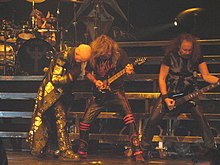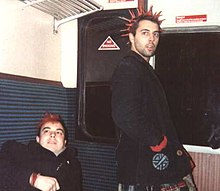
The punk subculture includes a diverse and widely known array of ideologies, fashion, and other forms of expression, visual art, dance, literature, and film. Largely characterised by anti-establishment views, the promotion of individual freedom, and the DIY ethics, the culture originated from punk rock.

Gothic fashion is a clothing style marked by dark, mysterious, antiquated, homogeneous, and often genderless features. It is worn by members of the goth subculture. Typical gothic fashion includes dyed black hair, exotic hairstyles, dark lipstick and dark clothing. Both male and female goths can wear dark eyeliner, dark nail polish and lipstick for a dramatic effect. Male goths use cosmetics at a higher rate than other men. Styles are often borrowed from the punk fashion and can also draw influence from Victorians and Elizabethan fashion. Goth fashion is sometimes confused with heavy metal fashion and emo fashion.

Fetish fashion is any style or appearance in the form of a type of clothing or accessory, created to be extreme, revealing, skimpy, or provocative in a fetishistic manner. These styles are by definition not worn by the majority of people; if everyone wears an item, it cannot have fetishistic, special nature. They are usually made of materials such as leather, latex or synthetic rubber or plastic, nylon, PVC, spandex, fishnet, and stainless steel. Some fetish fashion items include: stiletto heel shoes and boots, hobble skirts, corsets, collars, full-body latex catsuits, stockings, miniskirt, crotchless underwear, jockstraps, diapers, garters, locks, rings, zippers, eyewear, handcuffs, and stylized costumes based on more traditional outfits, such as wedding dresses that are almost completely see-through lace, or lingerie for men.
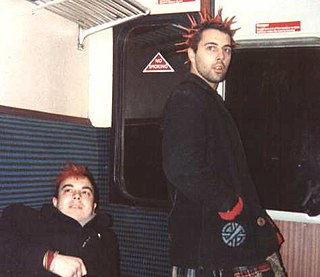
Punk fashion is the clothing, hairstyles, cosmetics, jewellery, and body modifications of the punk counterculture. Punk fashion varies widely, ranging from Vivienne Westwood designs to styles modeled on bands like The Exploited to the dressed-down look of North American hardcore. The distinct social dress of other subcultures and art movements, including glam rock, skinheads, greasers, and mods have influenced punk fashion. Punk fashion has likewise influenced the styles of these groups, as well as those of popular culture. Many punks use clothing as a way of making a statement.

Christian Ernest Dior was a French fashion designer and founder of one of the world's top fashion houses, Christian Dior SE. His fashion houses are known all around the world, having gained prominence "on five continents in only a decade."
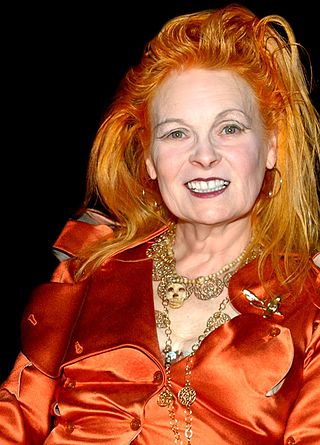
Dame Vivienne Isabel Westwood was a British fashion designer and businesswoman, largely responsible for bringing modern punk and new wave fashions into the mainstream. In 2022, Sky Arts ranked her the 4th most influential artist in Britain of the last 50 years.

A miniskirt is a skirt with its hemline well above the knees, generally at mid-thigh level, normally no longer than 10 cm (4 in) below the buttocks; and a dress with such a hemline is called a minidress or a miniskirt dress. A micro-miniskirt or microskirt is a miniskirt with its hemline at the upper thigh, at or just below crotch or underwear level.

A hobble skirt was a skirt with a narrow enough hem to significantly impede the wearer's stride. It was called a "hobble skirt" because it seemed to hobble any woman as she walked. Hobble skirts were a short-lived fashion trend that peaked between 1908 and 1914.

Bondage pants or bondage trousers are trousers with zippers, straps, chains, rings and buckles, giving an appearance of a BDSM style. They come in a variety of colors and patterns; one of the most common patterns being tartan. Bondage pants also come in a variety of styles, including tight or baggy, long, short or Capri.

Dame Zandra Lindsey Rhodes,, is an English fashion and textile designer. Her early education in fashion set the foundation for a career in the industry creating textile prints. Rhodes has designed garments for Diana, Princess of Wales and numerous celebrities such as rock stars Freddie Mercury and Marc Bolan. She has also designed textiles for interiors, featuring her prints on furniture and homewares. In 2003 Rhodes founded the Fashion and Textile Museum in London.
Sex was a boutique run by Vivienne Westwood and her then partner Malcolm McLaren at 430 King's Road, London between 1974 and 1976. It specialised in clothing that defined the look of the punk movement.

Manfred Thierry Mugler was a French fashion designer, creative director and creative adviser of Mugler. In the 1970s, Mugler launched his eponymous fashion house; and quickly rose to prominence in the following decades for his avant-garde, architectural, hyperfeminine and theatrical approach to haute couture. He was one of the first designers to champion diversity in his runway shows, which often tackled racism and ageism, and incorporated non-traditional models such as drag queens, porn stars, and transgender women. In 2002, he retired from the brand, and returned in 2013 as the creative adviser.

Fashion of the 1980s was characterized by a rejection of 1970s fashion. Punk fashion began as a reaction against both the hippie movement of the past decades and the materialist values of the current decade. The first half of the decade was relatively tame in comparison to the second half, which was when apparel became very bright and vivid in appearance.

Azzedine Alaïa was a Tunisian couturier and shoe designer, particularly successful beginning in the 1980s.

Fashion in the 1970s was about individuality. In the early 1970s, Vogue proclaimed "There are no rules in the fashion game now" due to overproduction flooding the market with cheap synthetic clothing. Common items included mini skirts, bell-bottoms popularized by hippies, vintage clothing from the 1950s and earlier, and the androgynous glam rock and disco styles that introduced platform shoes, bright colors, glitter, and satin.

Shoulder pads are a type of fabric-covered padding used in men's and women's clothing to give the wearer the illusion of having broader and less sloping shoulders. In the beginning, shoulder pads were shaped as a semicircle or small triangle and were stuffed with wool, cotton, or sawdust. They were positioned at the top of the sleeve to extend the shoulder line. A good example of this is their use in "leg o' mutton" sleeves or the smaller puffed sleeves which are based on styles from the 1890s. In men's styles, shoulder pads are often used in suits, jackets, and overcoats, usually sewn at the top of the shoulder and fastened between the lining and the outer fabric layer. In women's clothing, their inclusion depends on the fashion taste of the day. Although from a non-fashion point of view they are generally for people with narrow or sloping shoulders, there are also quite a few cases in which shoulder pads will be necessary for a suit or blazer in order to compensate for certain fabrics' natural properties, most notably suede blazers, due to the weight of the material. There are also periods when pads intended to exaggerate the width of the shoulders are favored. As such, they were popular additions to clothing during the 1930s and 1940s; the 1980s ; and the late 2000s to early 2010s.

Anti-fashion is an umbrella term for various styles of dress that are explicitly contrary to the fashion of the day. Anti-fashion styles may represent an attitude of indifference or may arise from political or practical goals which make fashion a secondary priority. The term is sometimes even used for styles championed by high-profile designers, when they encourage or create trends that do not follow the mainstream fashion of the time.
Jane Mulvagh is an Irish-born journalist and social historian, specialising in British history. She is best known for her history of Madresfield Court, the English country house upon which Evelyn Waugh based his novel Brideshead Revisited.
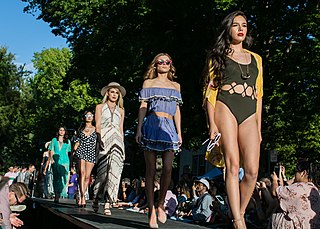
The trickle-up effect in the fashion field, also known as bubble-up pattern, is an innovative fashion theory first described by Paul Blumberg in the 1970s. This effect describes when new trends are found on the streets, showing how innovation flows from the lower class to upper class. It is in contrast with classical theories of fashion consumption, such as those of Georg Simmel and Thorstein Veblen, who theorize that the upper classes are the ones who dictate the fashion flow.
Roger Kenneth Burton is a British creative entrepreneur.

